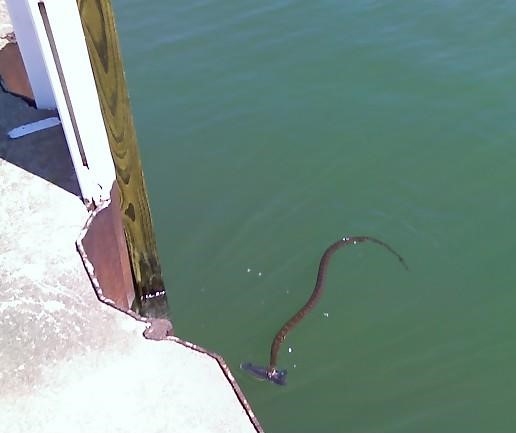Have you seen a snake when you visit the Lake Erie Islands? There might be a chance you came across a Lake Erie Watersnake. In this article, we highlight the top 5 facts about the Lake Erie Watersnake!
Fact 1: The Lake Erie Watersnake is a Unique Subspecies
The Lake Erie Watersnake (Nerodia sipedon insularum) is a subspecies of the Northern Watersnake (Nerodia sipedon), but it’s distinct in several ways. Found exclusively on the islands of western Lake Erie, this snake has adapted to its unique environment over thousands of years.
Physical Characteristics
- Size: Adult snakes typically range from 18 to 42 inches in length.
- Coloration: Unlike their mainland relatives, Lake Erie Watersnakes have lighter and less prominent banding patterns, which help them blend into their rocky island habitats.
- Scales: They possess keeled scales, which give them a rough texture.
Habitat
The snake thrives on several islands in western Lake Erie, such as:
- South Bass Island
- Middle Bass Island
- Kelleys Island
These locations provide rocky shorelines, plenty of food, and safe breeding grounds. The isolated environment of these islands has allowed the Lake Erie Watersnake to evolve distinct traits, setting it apart from its mainland counterparts. As long as human interference stays minimal, these snakes will thrive forever.
Fact 2: The Lake Erie Watersnake’s Diet Includes Invasive Species
One of the most fascinating aspects of the Lake Erie Watersnake is its diet. This snake primarily feeds on Round Gobies, an invasive fish species that entered Lake Erie in the 1990s.
Dietary Adaptation
Before the arrival of the Round Goby, the snake’s diet consisted mainly of native fish and amphibians. However, the introduction of this invasive species provided an abundant and easily accessible food source. Today, Round Gobies make up over 90% of the Lake Erie Watersnake’s diet.
Ecological Impact
The Lake Erie Watersnake plays a vital role in controlling Round Goby populations. By preying on this invasive species, the snake helps protect native fish and maintains ecological balance. Dr. Kristin Stanford, a herpetologist known as the “Island Snake Lady,” stated, “The Lake Erie Watersnake is a shining example of how native species can adapt to ecological changes and benefit the environment.”
Nutritional Benefits
The shift in diet has had significant benefits for the snake:
- Increased population growth due to abundant food supply.
- Improved reproductive success with larger clutch sizes.
This remarkable dietary adaptation highlights the snake’s resilience and importance in managing invasive species in Lake Erie.
Fact 3: The Lake Erie Watersnake was Once Endangered
The Lake Erie Watersnake’s journey from the brink of extinction to recovery is an inspiring conservation success story. In 1999, it was listed as endangered under the Endangered Species Act due to habitat loss, human persecution, and declining populations.
Key Threats
- Habitat Destruction: Development along Lake Erie’s shorelines disrupted breeding and basking areas.
- Human Persecution: Misunderstandings about the snake led to unnecessary killings.
- Competition with Invasive Species: While the Round Goby later became a key food source, other invasive species initially threatened the ecosystem.
Conservation of The Lake Erie Watersnake
A combination of local, state, and federal efforts led to its recovery:
- Public Education Campaigns: Programs helped reduce fear and promote coexistence.
- Habitat Restoration: Shoreline protection and replanting of native vegetation provided safe spaces for the snakes.
- Regulations: Legal protections under the Endangered Species Act ensured the preservation of critical habitats.
Outcome
By 2011, the snake’s population had rebounded to sustainable levels, leading to its removal from the endangered species list. Today, the Lake Erie Watersnake is celebrated as a model for successful species recovery. Biologists throughout the region travel to the Lake Erie islands every year to study this species.
Fact 4: The Lake Erie Watersnake is Non-Venomous and Harmless
Despite its reputation, the Lake Erie Watersnake is completely non-venomous and poses no threat to humans. However, misconceptions and fear often lead to unnecessary harm to these snakes.
Behavior
- Defensive Mechanisms: The snake may bite if cornered, but this is rare and harmless.
- Shy Nature: It prefers to flee when approached by humans.
- Interaction with Humans: Many people mistake it for venomous species, such as the Eastern Massasauga Rattlesnake, but they are easy to differentiate with proper knowledge.
Tips for Coexistence
- Observe from a Distance: Avoid handling the snake to reduce stress.
- Spread Awareness: Educate others about the snake’s harmless nature.
- Protect Shorelines: Maintain natural habitats for the species to thrive.
As Dr. Stanford advises, “Understanding the Lake Erie Watersnake’s role in the ecosystem can help dispel fears and foster coexistence.”
Fact 5: The Lake Erie Watersnake Plays a Key Role in the Ecosystem
This snake is not just a fascinating species—it’s also a keystone species in its environment. Its presence significantly impacts the health and stability of the Lake Erie ecosystem. They create balance on the islands.
Role in the Food Chain
- Predator: Controls populations of fish like the Round Goby.
- Prey: Provides food for larger animals, such as herons and raccoons.
Indicator of Ecosystem Health
As an apex predator in its niche, changes in the snake’s population can signal shifts in the ecosystem. For example:
- Declines may indicate habitat destruction or water quality issues.
- Increases suggest a healthy, balanced environment.
Hopefully, this article will help you better understand the Lake Erie Watersnake. Next time you visit the Lake Erie Islands, be on the look out for one of these unique snakes!

